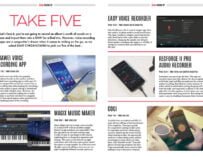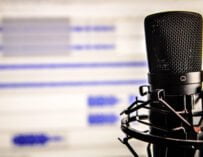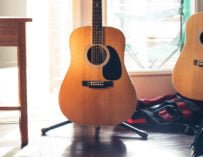
Olympus LS-12 (top) and LS-14 (bottom) audio recorders
Olympus brings two new models to the crowded portable recorder marketplace. We put them through their paces at Songwriting Live…
 hen Japan’s Zoom Corporation launched the H1 Handy Recorder back in the mid-noughties, they invented a whole new product sector. CD-quality recording from a device not much bigger than a traditional dictaphone? “Yes please,” said musicians the world over, and by the time the first decade of the new millennium drew to a close all the major music hardware manufacturers had their own portable recorders: the likes of Yamaha, Roland, Tascam, Korg and, of course, Olympus.
hen Japan’s Zoom Corporation launched the H1 Handy Recorder back in the mid-noughties, they invented a whole new product sector. CD-quality recording from a device not much bigger than a traditional dictaphone? “Yes please,” said musicians the world over, and by the time the first decade of the new millennium drew to a close all the major music hardware manufacturers had their own portable recorders: the likes of Yamaha, Roland, Tascam, Korg and, of course, Olympus.
Now, Olympus have two new models joining the party. The LS-12 and LS-14 are very similar in both appearance and features: the main differences are that the LS-12 has just 2GB of onboard memory while the LS-14 has 4GB, and that the LS-12 features only twin stereo mics while the LS-14 features a third, central microphone. The LS-14 also comes in a matt, gunmetal finish while the LS-14 is shiny and black.
Both recorders capture audio in your choice of PCM (WAV) and MP3 formats, with resolutions selectable from 44.1kHz/mono to 96kHz/24-bit (PCM), and 64 to 320kpbs (MP3). Both also feature a choice of recording modes: Manual, Smart and Quick. The difference here lies in the setting of recording levels: in Manual mode you adjust levels manually as you go along, in Smart mode the recorder will automatically adjust levels in response to the incoming sound levels, while in Quick mode the recorder will set the level automatically at the start of the recording and leave it there. We’d suggest Smart mode offers the best pay-off between ease of use and sound quality, but to be honest there’s not a huge amount in it.
The results, it has to be said, were very impressive
These models also offer a number of features that will help you capture the best possible recordings. There’s a three-way mic gain selector (low/middle/high), a built-in limiter (which can be turned off if you prefer), and a high-pass filter, which is switchable between 100Hz/300Hz or can also be turned off. These more advanced features are accessed via the menu system, which is highly intuitive. The various, logically set-out menu options are displayed on the backlit LCD and selected using either the jogdial and its central OK button, or by hitting the function button below the onscreen option of your choice.
The LS-14 also has a Siri-like voice that reads out the various options as you scroll and click your way through them, which could be very useful if, for instance, you’re trying to set up to record your band in a dimly lit venue.
What’s more, the LS-14 also offers an overdub mode. This isn’t true multitrack recording – for that you’d need the more expensive LS-100 – but it could still prove extremely useful for the solo singer-songwriter recording demos at home, as could the built-in chromatic tuner and metronome. The latter can be set anywhere from 40 to 250bpm in 1bpm increments, and gives you both a ‘click track’ (actually a ‘beep track’) and a flashing light on the front of the unit.
Speaking of the front of the unit, this is where you’ll find the aforementioned jogdial and function buttons, plus play/stop/record buttons, a dial to select between the three recording modes and an Erase button. On the sides are Line and Mic ins, a 3.5mm headphone jack, a port for an optional Olympus remote control unit and a micro-USB port, plus an SD card slot that will let you extend the available memory by up to 32GB.
We road-tested these two recorders at a couple of our Songwriting Live events in Bristol, recording both via the line-in direct from the mixing desk, and simply by placing the recorder at the back of the room and using the built-in mics. And the results, it has to be said, were very impressive. The ‘ambient’ mic picked up every audience whisper going on around it, yet still recorded the music coming from the PA clearly, while the quality of the recording straight from the desk simply couldn’t be faulted. If you’re looking for high-quality recording at a price that won’t break the bank, these two Olympus recorders come highly recommended.
Verdict: An impressive range of musician-friendly features at a sensible price
![]()
![]()
![]()
![]()
![]()
Russell Deeks
[cc_full_width_col background_color=”f1f1f1″ shadow_color=”cccccc” radius=”6″]LS-12 specifications
- Mode Dial & Smart Mode
- Linear PCM recording (96kHz/24bit)
- Two high-sensitivity 90° mics
- Acoustic resistance of 130 dBspl
- Battery Life: Up to 50 hours of continuous recording
- Separate audio & system circuitry
- Switchable low-cut filter (100Hz/300Hz)
- Pre-record buffer
LS-14 specifications
- Mode Dial & Smart Mode
- Linear PCM recording (96kHz/24bit)
- TRESMIC 3-microphone system
- Acoustic resistance of 130 dBspl
- Battery Life: Up to 46 hours of continuous recording
- Separate audio & system circuitry
- Switchable low-cut filter (100Hz/300Hz)
- Pre-record buffer
Price
£149.99 (LS-12) / £229.99 (LS-14)
Website
www.olympus.co.uk
[/cc_full_width_col]







![Interview: Jessie Jo Dillon [2025]](https://www.songwritingmagazine.co.uk/wp-content/uploads/jessie-jo-dillon-2-by-libby-danforth-335x256.jpg)


























Related Articles